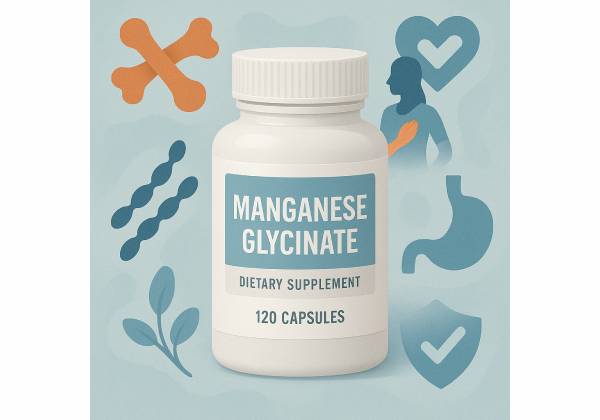
Manganese glycinate is a chelated form of manganese in which the essential trace mineral is bound to glycine, a small amino acid. Chelation can make a mineral easier to tolerate in the gut and helps it travel through the intestinal wall alongside amino acids. Your body needs manganese in tiny amounts to activate dozens of enzymes that power energy metabolism, antioxidant defense (notably mitochondrial manganese superoxide dismutase), collagen and proteoglycan formation for bone and joint health, and normal blood clotting. While manganese is easy to get from food, some people consider a supplement during periods of increased demand, when diets are highly refined, or when a multivitamin contains little or no manganese. That said, more is not better. Because manganese is primarily excreted in bile, very high intake or impaired biliary excretion can raise blood levels, and long-term excess is linked to neurological harm. This guide explains what manganese glycinate can (and cannot) do, practical dosing, who should avoid it, and how to use it safely with other nutrients and medicines.
Essential Insights
- Supports antioxidant defense (MnSOD) and connective tissue formation that underpins bone and joint integrity.
- Typical supplemental elemental manganese: 0.5–3 mg/day; total daily intake from all sources should remain conservative.
- Keep total manganese below adult safe levels set by authorities; chronic high intake may be neurotoxic.
- Avoid if you have cholestasis or chronic liver disease, or significant occupational manganese exposure; seek clinician guidance.
Table of Contents
- What is manganese glycinate and why use it?
- Proven benefits: what it can and cannot do
- How to take it: dosage and timing
- Absorption factors and smart stacking
- Side effects, interactions, who should avoid
- What the evidence says today
What is manganese glycinate and why use it?
Manganese is an essential trace mineral present in whole grains, legumes, nuts, tea, coffee, and spices. In your body, it acts as a catalyst: it sits at the heart of enzymes that help convert carbohydrates and fat into usable energy, steady oxidative stress inside mitochondria, and build the proteoglycans that make bone resilient and cartilage springy. Manganese also supports arginase (urea cycle), pyruvate carboxylase (gluconeogenesis), and enzymes involved in blood clotting alongside vitamin K.
Manganese glycinate is a form designed for gentler digestion. The metal ion is bound to glycine, forming a small, neutral complex that uses amino-acid transport pathways through the intestinal wall. People often choose glycinate salts when they’ve had stomach upset with inorganic salts such as sulfates or chlorides. That preference is reasonable for comfort; however, for manganese specifically, head-to-head human trials have not established that glycinate raises manganese status more effectively than other well-absorbed salts. In practice, the “best” form is the one you tolerate, dosed conservatively and aligned with your total dietary intake.
Why supplement at all if the mineral is common in food? There are a few niche scenarios:
- Low-manganese diets: Highly refined dietary patterns that minimize whole grains, legumes, nuts, tea, and spices may fall short.
- Targeted joint formulas: Some bone and joint blends include small amounts of manganese to support matrix enzymes that construct cartilage and bone.
- Multivitamin coverage: Not all multivitamins contain manganese; others include only a token amount. If a clinician has advised matching dietary reference values, a low-dose add-on may be used.
Even in these cases, the goal is to top up, not push intake high. Background diets in many regions already provide roughly 2–6 mg/day. Authorities have advised staying within conservative safe levels for total intake, especially because long-term excess can accumulate in the basal ganglia and affect movement.
Key takeaways for this section: manganese glycinate is a tolerable, amino-acid–chelated form that may sit better for sensitive stomachs; it’s appropriate mainly for low-dose insurance or targeted blends, not for high-dose “performance” use. Always consider total intake from food, water, and supplements before adding any pill.
Proven benefits: what it can and cannot do
Antioxidant defense inside mitochondria. Manganese is required to assemble manganese superoxide dismutase (MnSOD), the enzyme that disarms superoxide radicals within mitochondria. Without adequate manganese, MnSOD activity declines, and cells become more vulnerable to oxidative stress. This is a foundational, not flashy, benefit: you won’t “feel” MnSOD working, but normal activity is essential for cellular housekeeping.
Connective tissue and bone. Manganese-dependent enzymes help build the carbohydrate side chains that give cartilage its shock-absorbing quality and help mineralize bone. In animals, manganese deficiency impairs bone formation; in humans, the signals are subtler, but bone and joint formulas sometimes include modest manganese (often alongside calcium, vitamin D, zinc, copper, and boron) to support matrix turnover. Manganese is a supporting actor here—useful as part of a multi-nutrient program, not a solo solution for osteoporosis or joint pain.
Glucose and lipid metabolism. Manganese participates in gluconeogenesis and macronutrient metabolism. That mechanistic role has prompted interest in blood-sugar support, but translating enzyme biochemistry into clinical outcomes is tricky. Observational studies link blood or hair manganese with various metabolic measures, yet those biomarkers fluctuate with exposure and don’t necessarily track functional status. Bottom line: manganese is necessary for normal metabolism; supplementation beyond normal intake has not been shown to improve glycemic control in otherwise well-nourished adults.
Neurological function—support vs risk. Adequate manganese is required for normal neurotransmitter synthesis and antioxidant protection in neural tissue. However, the central nervous system is also where manganese excess does harm. Chronic high intake or impaired excretion can elevate brain manganese and cause parkinsonian features (slowed movement, rigidity), typically after long exposure. The practical message is balance: you need enough for enzyme function, but pushing higher doses confers no cognitive benefit and raises risk.
Immune and reproductive health. Manganese influences immune signaling and reproductive processes through its enzyme roles. Again, that does not automatically mean extra manganese boosts immunity or fertility. Most adults achieve sufficient intake through food.
What manganese glycinate cannot do. It is not an ergogenic aid, a mood enhancer, or a quick fix for joint pain. Claims that specific chelated forms “work better” are not supported by strong human data for manganese. The most credible use case is meeting—but not exceeding— conservative daily needs in a tolerable form.
Practical expectation setting:
- If your diet includes oats, brown rice, beans, nuts, and tea, you likely meet needs already. A supplement may be redundant.
- If your multivitamin provides ~1–2.3 mg elemental manganese, that ordinarily covers daily requirements.
- If you and your clinician decide to add manganese, aim low (often 0.5–2 mg/day elemental), track total intake, and re-evaluate after a defined period rather than taking it indefinitely.
How to take it: dosage and timing
Read labels for elemental manganese. Supplement facts list elemental manganese—the amount of manganese itself—rather than the weight of the whole compound. A capsule might say “Manganese (as glycinate) 2 mg,” which means 2 mg elemental manganese delivered as a glycinate chelate.
Conservative daily ranges. For most adults considering manganese glycinate, 0.5–3 mg elemental manganese per day is a prudent supplemental range, especially if you already eat manganese-containing foods. Many multivitamins fall around 1–2.3 mg. Specialty products sometimes reach 5–10 mg per serving; those higher doses rarely make sense outside clinician-directed use and can push total intake toward levels associated with increased risk.
Total daily intake matters. Add up:
- Diet (often 2–6 mg/day from whole-food patterns)
- Drinking water (typically small amounts, but local groundwater can vary)
- Multivitamin/mineral products
- Targeted bone/joint or antioxidant blends that quietly include manganese
Keep your combined total in a conservative band. Health authorities in recent evaluations set adult safe levels grounded in typical high consumer diets rather than a true toxic threshold; staying well below those ceilings provides a margin of safety, particularly for long-term users.
Timing with meals. Take manganese glycinate with food to mimic natural intake and reduce the chance of nausea. Because amino acids compete for transporters and minerals can jostle for absorption, spreading multi-mineral supplements across the day is reasonable (for example, breakfast and dinner) if your regimen includes iron, zinc, calcium, and magnesium.
Short courses, then reassess. If you adopted manganese glycinate because your diet was temporarily limited (travel, recovery, elimination diet), consider a time-boxed trial (e.g., 8–12 weeks), then taper off once your menu broadens. Long-term daily supplementation without a defined need is not advisable.
Special populations.
- Pregnancy and lactation: Needs are modestly higher, but routine high-dose supplementation is unnecessary and potentially risky. Rely on a standard prenatal or clinician-directed plan rather than adding stand-alone manganese.
- Children and adolescents: Do not supplement outside medical advice; their safe intake thresholds are lower on a body-weight basis.
- Liver or biliary disease, cholestasis: Avoid supplemental manganese unless a specialist explicitly recommends and monitors it.
Missed a dose? Skip and resume at the next scheduled time. Do not double up; that practice is inappropriate for trace minerals.
Storage and quality. Choose brands that clearly state elemental amounts and the form (“manganese glycinate chelate” or “bisglycinate chelate”) and that undergo third-party testing. Store in a cool, dry place away from children; even “small” minerals can be harmful if ingested in quantity by a child.
Absorption factors and smart stacking
Your iron status changes manganese uptake. The intestine up-regulates transporters when iron is low, and this can increase manganese absorption—a natural safeguard that keeps critical metalloenzymes supplied during deficiency. The implication: people with iron deficiency may absorb more manganese from the same dose, potentially overshooting targets. If you are correcting iron deficiency, be particularly cautious about layering manganese supplements.
Dietary patterns. Tea, coffee, whole grains, beans, nuts, and spices provide manganese that’s largely well absorbed despite phytate. Because manganese requirements are low and food sources abundant, most adults with varied diets do not need a pill.
Competing minerals. High intakes of calcium, iron, magnesium, and zinc can reduce absorption of one another when taken together as large single doses. For mixed mineral regimens, split doses across breakfast and dinner rather than piling all tablets at once. If iron therapy is part of your plan, keep manganese low and separate dosing as advised by your clinician.
Chelation form vs bioavailability. Chelates like glycinate are popular because they tend to be gentler on the stomach and may avoid some insoluble complexes in the gut lumen. For manganese specifically, robust human trials comparing glycinate to sulfate, gluconate, citrate, or chloride are lacking. Practical guidance: choose a form you tolerate, verify the elemental amount, and keep the dose conservative.
Formulation tips for common goals.
- Bone or joint support: Instead of increasing manganese, ensure your base includes vitamin D, calcium (diet first), magnesium, vitamin K2, zinc, copper, and boron. Manganese plays a supporting role at low doses (often 1–2 mg/day) within that stack.
- Antioxidant systems: If your aim is mitochondrial resilience, focus upstream on sleep, aerobic capacity, and diet quality (polyphenols, omega-3s). A low-dose manganese provides cofactors but is not a standalone antioxidant therapy.
Water and environment. Some private wells naturally contain more manganese. If you rely on well water, a simple mineral analysis can clarify baseline exposure. This is particularly relevant for households with infants or where multiple household members also take mineral supplements.
What to pair (and not) with manganese.
- Pair with: Balanced multi-mineral formulas; protein-rich meals that support amino-acid transport; vitamin C–rich foods (for overall mineral uptake synergy).
- Avoid with (same time): Iron therapy, calcium megadoses, and mineral antacids; fluoroquinolone or tetracycline antibiotics (see next section) where timing separation is essential.
Monitoring without over-testing. Routine blood manganese testing is rarely informative for healthy people because circulating levels don’t track intake tightly. The better gauge is exposure history (diet, water, supplements, workplace) plus clinical context. If you have a liver or biliary condition, your specialist may check whole-blood manganese or MRI signal changes in specific scenarios.
Side effects, interactions, who should avoid
Common tolerability. At low doses with food, manganese glycinate is generally well tolerated. Occasional nausea can occur if taken on an empty stomach. Allergic reactions to the glycinate ligand are exceedingly rare.
Neurological risk from excess. The serious concern with manganese is chronic overexposure, not acute toxicity from a single tablet. Over months to years, high intake—especially in the setting of impaired biliary excretion—can elevate brain manganese and produce parkinsonian features (slowness, rigidity, gait changes). This has long been recognized in occupational settings with inhalational exposure; it can also occur orally when cumulative intake is persistently high. That is why conservative supplemental dosing and attention to total intake are non-negotiable.
Liver and biliary disease. Because manganese is excreted primarily in bile, people with cholestasis, cirrhosis, or obstructive biliary conditions can accumulate manganese even at modest intakes. They should avoid stand-alone manganese supplements unless a specialist directs and monitors them.
Children and pregnancy. Children have lower safe thresholds on a per-kilogram basis and should not receive manganese supplements outside medical advice. During pregnancy and lactation, needs are only modestly different, and routine high-dose manganese supplements are unnecessary. A standard prenatal typically suffices.
Drug interactions (separate by hours).
- Fluoroquinolone antibiotics (e.g., ciprofloxacin, levofloxacin) and tetracyclines (e.g., doxycycline, minocycline): polyvalent minerals chelate these drugs and block absorption. Separate manganese (and other minerals) from these antibiotics by the interval your prescriber recommends—commonly avoid minerals for several hours before and after each antibiotic dose.
- Iron therapy: Large iron doses compete with manganese for transport; take them at different times of day and keep manganese dosing minimal.
- Levodopa: Minerals can reduce levodopa absorption; follow your neurologist’s timing instructions if you use mixed mineral supplements.
Signs you may be getting too much. Early features are nonspecific: fatigue, headaches, irritability, and sleep changes. Over time, motor symptoms or cognitive slowing can appear. If you develop new neurological symptoms and take mineral supplements, discuss total exposure (including water) with your clinician.
Practical safety rules.
- Prefer food first; supplement only to cover a clear gap.
- Keep elemental manganese low (often 0.5–2 mg/day) if you supplement.
- Track total intake across diet, water, multivitamins, and specialty products.
- Avoid supplemental manganese if you have liver or biliary disease unless your specialist instructs otherwise.
- Separate from interacting antibiotics and high-dose iron or calcium.
- Re-evaluate need every few months rather than taking manganese indefinitely.
What the evidence says today
Dietary sufficiency is common. Large dietary assessments from Europe and the Nordics place typical adult intakes in the 2–6 mg/day range, with top contributors being grains, legumes, nuts, tea, coffee, and spices. In such contexts, frank deficiency is rare and usually tied to experimental diets or parenteral nutrition without trace elements. For most people, the everyday menu provides enough manganese for enzyme function.
Supplement form comparisons are limited. For manganese, unlike magnesium or iron, high-quality human trials comparing glycinate to sulfate, gluconate, citrate, or chloride are scarce. Authoritative fact sheets explicitly note the absence of solid comparative bioavailability data between supplemental forms. The best supported claim for glycinate is tolerability, not superiority.
Safe intake boundaries reflect prudence, not precise toxicity thresholds. Recent expert reviews concluded that evidence is inadequate to define a clear oral dose-response for neurotoxicity in humans. Instead, they proposed conservative safe intake levels for adults based on high-consumer background diets and the desire to prevent gradual accumulation. That framework underscores a practical rule: when evidence gaps exist, err on the low side—especially for long-term daily use.
Neurological risk is real at high exposure. Contemporary reviews of epidemiology and mechanistic studies link chronic manganese excess with parkinsonian outcomes. The pattern is most robust in occupational inhalational exposure but remains relevant for oral intake when cumulative load is high or excretion is impaired. This is not a reason to fear normal dietary manganese; it is a reminder that avoiding unnecessary supplementation is wise.
Drug–mineral chelation is well documented. The interaction between polyvalent cations and certain antibiotics is not theoretical. Real-world audits show frequent co-administration errors and under-separation of doses. If you ever need a fluoroquinolone or tetracycline, treat all mineral supplements (including manganese) as potential blockers and separate them per prescription instructions.
Bottom line for users. If your diet is varied, you likely do not need manganese glycinate. If you use it to round out a minimalist multivitamin or a temporary restricted diet, keep the dose small, count total intake, and set a stop-date to reassess. In mineral nutrition, adequacy beats excess every time.
References
- Manganese – Health Professional Fact Sheet 2021 (Guideline)
- Scientific opinion on the tolerable upper intake level for manganese 2023 (Guideline)
- Manganese – a scoping review for Nordic Nutrition Recommendations 2023 2024 (Systematic Review)
- Manganese-Induced Parkinsonism: Evidence from Epidemiological and Experimental Studies 2023 (Systematic Review)
- Multivalent cations interactions with fluoroquinolones or tetracyclines: A cross-sectional study 2021 (Observational Study)
Disclaimer
This article provides general information about manganese glycinate for educational purposes. It is not medical advice and does not replace consultation, diagnosis, or treatment from a qualified health professional. Do not start, stop, or change any supplement or medication based on this content. If you are pregnant, nursing, managing a medical condition (especially liver or biliary disease), have occupational exposure to manganese, or take prescription medicines, speak with your clinician before using manganese supplements.
If you found this guide helpful, please consider sharing it with a friend or on your favorite platform (Facebook, X, or elsewhere) and follow us for future evidence-based articles. Your support helps us continue creating high-quality health content.










